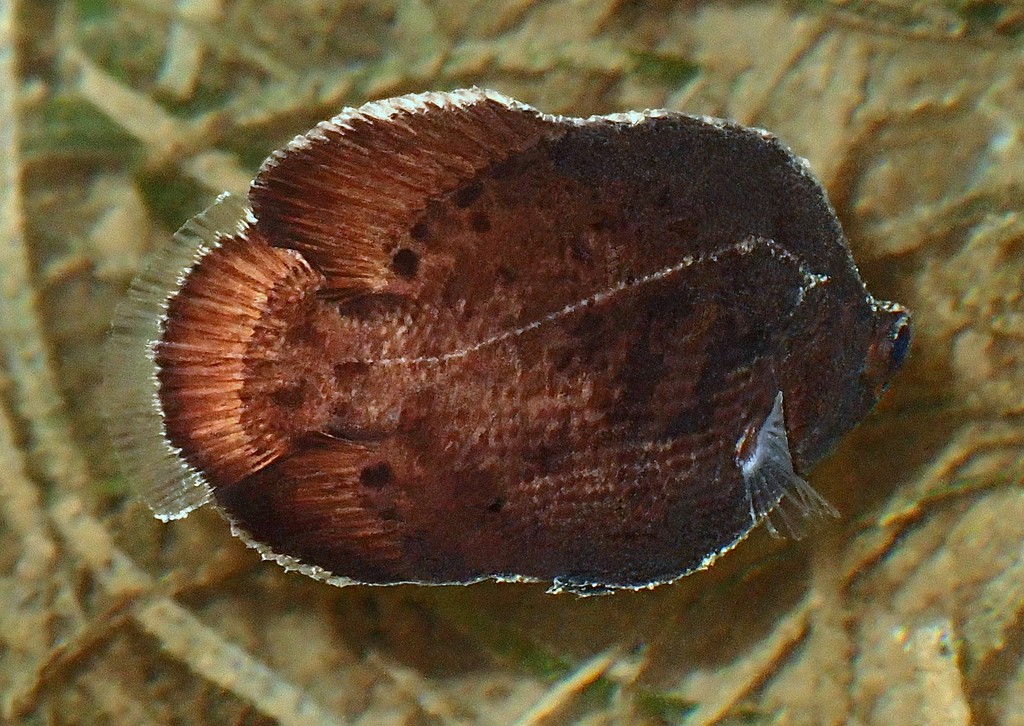LOBOTES SURINAMENSIS - (BLOCH, 1790)
Picture courtesy of: Alain Daoulas
Actinopterygii (Gigaclass) > Actinopteri (Class) > Teleostei (Subclass) > Acanthuriformes (Order) > Lobotidae (Family) > Lobotes (Genus)
Croupia roche, Poisson triple queue, Mérou de bois, Atlantic tripletail, Tripletail, Flasher, Black perch, Dusky perch, Jumping cod, Triple-tail, Tripple tail, Dreischwanzbarsch, Driestert, Pesce foglia, Peixe-folha, Furriel, Cua triple, Tres colitas, dormilona del Atlántico, Matsudai, マツダイ, 백미돔, Λοβόψαρο, 打铁婆, 松鯛,
Synonymes
Bodianus triourus (Mitchill, 1815)
Holocentrus surinamensis (Bloch, 1790)
Lobotes auctorum (Günther, 1859)
Lobotes citrinus (Richardson, 1846)
Lobotes erate (Cuvier, 1830)
Lobotes farkharii (Cuvier, 1830)
Lobotes incurvus (Richardson, 1846)
Lobotes somnolentus (Cuvier, 1830)
Lobotus surinamensis (Bloch, 1790)
--------------------------
Description
Dorsal spines (total): 11-12; Dorsal soft rays (total): 15-16; Anal spines: 3; Anal soft rays: 11-12; Pectoral fin rays: 17; Lateral line scales: 43-45; Gill rakers on first arch: 6-7 + 13-15; Boby oval to oblong, its depth: 2.0-2.5 in SL; The dorsal and anal fins rounded and symmetrical so that with the tail they appear to be a single three-lobed fin. Head dish-shaped, interorbital space narrow, upper profile concave; Eye relatively small; No subocular shelf visible externally; Mouth large, slightly oblique, upper jaw protractile; Maxilla not slipping under preorbital bone when mouth closed; No teeth on roof of mouth; Preopercle with strong dentitions along its margin. Bases of dorsal and anal fins scaled; Pectoral fins shorter than pelvic fins. Max. length: 110 cm TL, common length: 80.0 cm TL. Max. published weight: 19.2 kg. Depth range: 0 - 70 m.
Color
Varying shades of yellow brown to dark brown with ill defined spots and mottling. The young are often bright yellowish, becoming darker with age. Pectorals pale yellow, other fins darker than body; Caudal fin with yellow margin.
Etymology
Lobotes: from Ancient Greek, lobós = lobate, any projection or division, especially one of a somewhat rounded form. Referring the soft parts of the dorsal, anal, and caudal fins are thought to resemble one three-lobed fin.
surinamensis: from type locality, Suriname.
Original description: Holocentrus surinamensis Bloch, 1790 - Type locality: Suriname, Caribbean Sea.
Distribution
Circumglobal in tropical and warm temperate seas (including Caribbean Sea, Mediterranean Sea, Sea of Marmara, Red Sea, Persian Gulf, South China Sea, Sea of Japan), except for eastern Pacific.
Biology
Similar species
Lobotes pacifica (Gilbert, 1898) - Reported from Eastern Pacific: southern California (U.S.A.) south to Peru, including Gulf of California (Mexico), Guadalupe Island and Revillagigedo Islands (Mexico) and Cocos Island (Costa Rica).
Actinopterygii (Gigaclass) > Actinopteri (Class) > Teleostei (Subclass) > Acanthuriformes (Order) > Lobotidae (Family) > Lobotes (Genus)
Croupia roche, Poisson triple queue, Mérou de bois, Atlantic tripletail, Tripletail, Flasher, Black perch, Dusky perch, Jumping cod, Triple-tail, Tripple tail, Dreischwanzbarsch, Driestert, Pesce foglia, Peixe-folha, Furriel, Cua triple, Tres colitas, dormilona del Atlántico, Matsudai, マツダイ, 백미돔, Λοβόψαρο, 打铁婆, 松鯛,
Synonymes
Bodianus triourus (Mitchill, 1815)
Holocentrus surinamensis (Bloch, 1790)
Lobotes auctorum (Günther, 1859)
Lobotes citrinus (Richardson, 1846)
Lobotes erate (Cuvier, 1830)
Lobotes farkharii (Cuvier, 1830)
Lobotes incurvus (Richardson, 1846)
Lobotes somnolentus (Cuvier, 1830)
Lobotus surinamensis (Bloch, 1790)
--------------------------
Description
Dorsal spines (total): 11-12; Dorsal soft rays (total): 15-16; Anal spines: 3; Anal soft rays: 11-12; Pectoral fin rays: 17; Lateral line scales: 43-45; Gill rakers on first arch: 6-7 + 13-15; Boby oval to oblong, its depth: 2.0-2.5 in SL; The dorsal and anal fins rounded and symmetrical so that with the tail they appear to be a single three-lobed fin. Head dish-shaped, interorbital space narrow, upper profile concave; Eye relatively small; No subocular shelf visible externally; Mouth large, slightly oblique, upper jaw protractile; Maxilla not slipping under preorbital bone when mouth closed; No teeth on roof of mouth; Preopercle with strong dentitions along its margin. Bases of dorsal and anal fins scaled; Pectoral fins shorter than pelvic fins. Max. length: 110 cm TL, common length: 80.0 cm TL. Max. published weight: 19.2 kg. Depth range: 0 - 70 m.
Color
Varying shades of yellow brown to dark brown with ill defined spots and mottling. The young are often bright yellowish, becoming darker with age. Pectorals pale yellow, other fins darker than body; Caudal fin with yellow margin.
Etymology
Lobotes: from Ancient Greek, lobós = lobate, any projection or division, especially one of a somewhat rounded form. Referring the soft parts of the dorsal, anal, and caudal fins are thought to resemble one three-lobed fin.
surinamensis: from type locality, Suriname.
Original description: Holocentrus surinamensis Bloch, 1790 - Type locality: Suriname, Caribbean Sea.
Distribution
Circumglobal in tropical and warm temperate seas (including Caribbean Sea, Mediterranean Sea, Sea of Marmara, Red Sea, Persian Gulf, South China Sea, Sea of Japan), except for eastern Pacific.
Biology
Adult inhabits bays, muddy estuaries and lower reaches of large rivers. A sluggish offshore fish that often floats on its side near the surface in the company of floating objects. This is thought to be a feeding strategy because of the locality of their prey items and the floating structures associated with this behavior. Occasionally drifts over reefs. Juvenile may occur in floating Sargassum and mimic a floating leaf. Feeds on benthic crustaceans and small fish. leaves. Opportunistic eaters; They feed on a variety of foods, mostly small finfish. They also feed on invertebrates such as crabs and shrimp, as well as other benthic crustaceans. Caught with haul seines, gill nets, and on line gear. Marketed fresh. The flesh is said to be of excellent quality.
Similar species
Lobotes pacifica (Gilbert, 1898) - Reported from Eastern Pacific: southern California (U.S.A.) south to Peru, including Gulf of California (Mexico), Guadalupe Island and Revillagigedo Islands (Mexico) and Cocos Island (Costa Rica).
Last update: 23, March 2023
